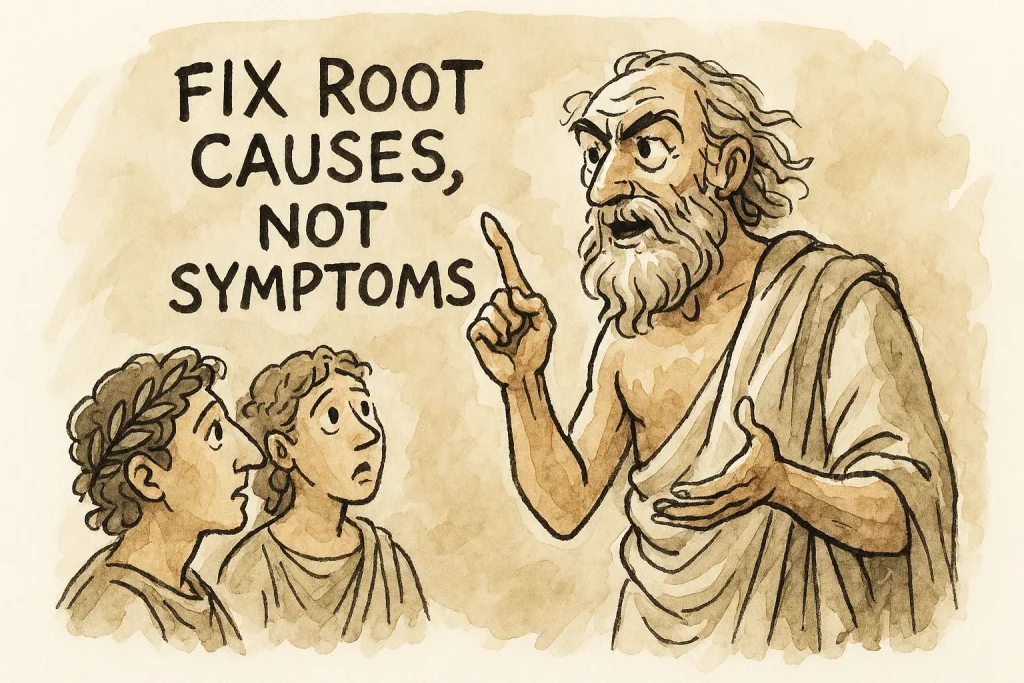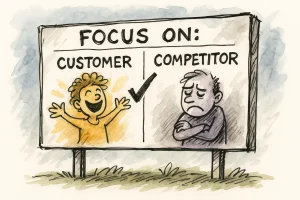
When something goes wrong, the most common reaction is to “put out the fire”: offer a discount to calm the client, extend the deadline, add more people to the task, send an email “reinforcing what was agreed”. All of this eases the pain for a few hours – and the problem returns, sometimes bigger. Symptoms are loud – root causes are quiet. If you don’t address the source, you’ll keep repeating the patch.
Symptom vs. Cause: how to tell the difference
- Late delivery is a symptom; the lack of a simple pre-send checklist is the cause.
- Irritated client is a symptom; poorly aligned expectations in the proposal are the cause.
- Tired team is a symptom; priorities changing every week are the cause.
- Weak sales are a symptom; poorly defined audience and generic messaging are the cause.
A simple method to get to the root
- Describe the fact, without labels
“Tuesday reports arrive incomplete”. Not “so-and-so is disorganized”. - Do the “5 Whys”
Ask “why?” until you reach something about process, rule, skill, or tool. Stop when the answer stops blaming people and points to a real mechanism.
Example: Why was it late? Because information was missing. Why? The client didn’t send it. Why? The form allows submission without essential fields. Cause: poorly designed form. - Look at the whole flow
Map 5-7 steps of the journey (order → production → review → delivery). Where is the ball dropped? Which step creates the most rework? - Collect data, even if just a little
Three numbers are enough: cycle time, error rate, where the error starts. You don’t need BI – you need to count correctly for two weeks. - Test one small adjustment
Change one thing at a time: a required field, a proposal template, a review time slot, a “stop point” for checks. - Measure again
If the error rate dropped, standardize it. If not, discard and try another hypothesis. Root causes rarely disappear with speeches; they disappear with better work design.
Practical examples
- High delinquency
Symptom: late invoices.
Root cause: payment terms longer than supplier terms + collections without a clear date.
Adjustment: receive before you pay; predictable invoice due dates; friendly automatic reminder 5 days prior; instant-payment link.
Effect: fewer late payments, healthier cash flow. - Design rework
Symptom: the client “never likes it.”
Root cause: loose briefing and approval only at the end.
Adjustment: mandatory question script, board of visual references, rough draft approval before final art.
Effect: fewer back-and-forths, shorter timelines. - Support backlog
Symptom: many tickets.
Root cause: recurring confusion about the same poorly explained feature.
Adjustment: 60-second in-product tutorial + clear canned response + help button in the right place.
Effect: drop in repeated tickets.
Simple rules to avoid treating only the symptom
- Repeat error becomes a new rule: each relevant failure creates a checklist item, a required field, a naming standard.
- Decisions need an owner and a date: without a responsible person, the “improvement” becomes a loose idea.
- One change at a time: changing everything prevents you from knowing what worked.
- One-line success criterion: “reduce delays from 32% to 15% in 30 days”.
Traps that pull you back to patchwork
- Blaming people: when the process is weak, results depend on heroes. Heroes burn out.
- “Lecturing” instead of adjusting: long meetings don’t replace a well-made form.
- Vanity metrics: tracking likes and impressions when the problem is deadlines and margin.
- Giant solutions: buying an expensive system to solve something a checklist would fix.
A 30-minute weekly ritual
- Pick a bottleneck (the one that hurts most).
- Bring the fact and three numbers from last week.
- Run 5 Whys until you reach process/skill/tool.
- Set a 7-day test with an owner and date.
- Note what to change for good if it works.
A 10-day starter plan
- Days 1-2: list the three symptoms that cost the most time and money.
- Day 3: do 5 Whys on the biggest one; choose a cause hypothesis.
- Days 4-6: implement one small adjustment.
- Days 7-9: measure the effect and gather feedback from the team/client.
- Day 10: standardize or discard; pick the next symptom.
Why does this matter?
Because patches relieve; root fixes transform. When you address the root, the problem doesn’t return, the team gains rhythm, the client feels real improvement, and your cash flow thanks you. Firefighting keeps the company busy. Fixing the source moves the company forward.





